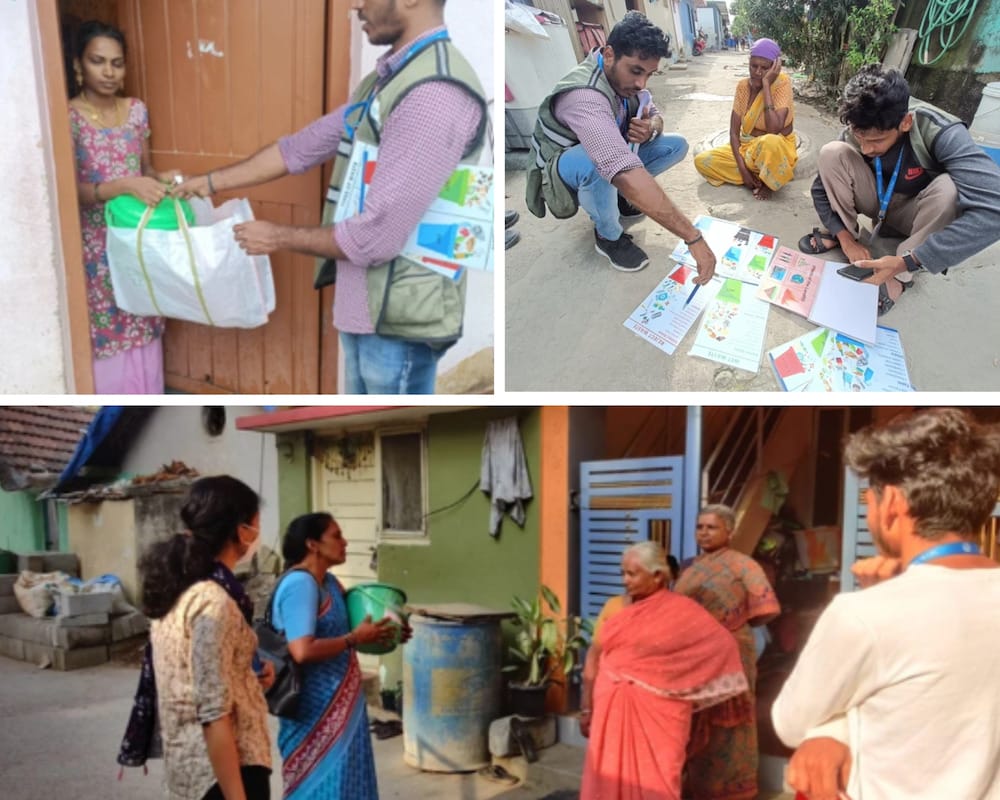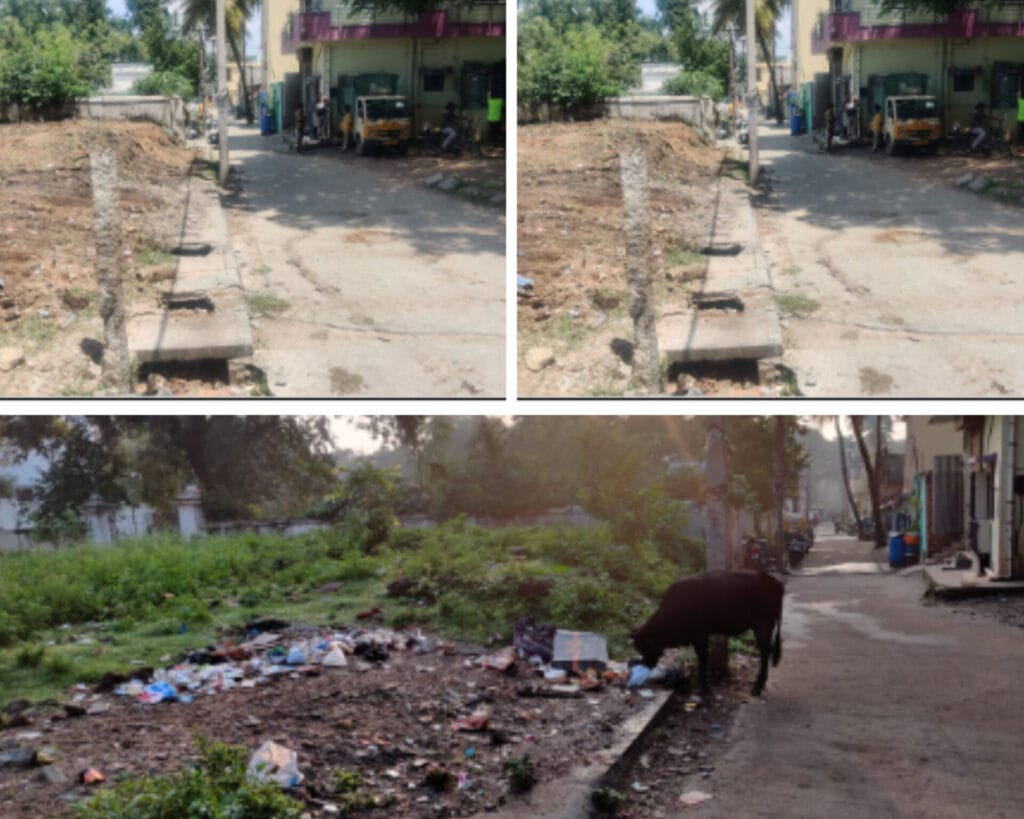Bengaluru is experiencing a surge in migration, due to rapid urbanisation and population growth, leading to the rise of urban poor settlements or slums. These slums face daily challenges, including improper housing, inadequate access to water, sanitation, waste management, and other basic facilities. The prevalent unhygienic conditions in these settlements contribute to health issues, notably a surge in diseases like dengue while nearby government hospitals often lack the necessary facilities.
A critical issue is improper waste management in these areas. There are disparities in opportunities for dumping, collecting, and disposing of waste. This further compounds the challenges faced by the urban poor. Community members are forced to dump waste nearby, leading to the creation of black spots. These areas attract flies and other insects, fostering unhygienic conditions. This article provides insight into the realities of waste management in the slums and emphasises the need for a thoughtful and sustainable approach.
In response to these challenges, #TeamLBTC (Let’s Be The Change) decided to address the root cause of the waste management problem in Bengaluru’s slums, starting with Mestri Palya.
Waste management issues in Mestri Palya
Mestri Palya, home to over 2,000 urban residents, comprising more than 450 households, generates more than 700 kilograms of waste daily. Shockingly, less than 10% of this waste is properly sorted, and less than 20% is collected for disposal.
We divided our project into two phases: The first, from July 2021 to August 2022, focused on understanding the community’s needs and bringing about behavioural change. The second, starting from July 2022 until December 2023, aims towards the long-term maintenance of the change.
During our visits with government officials, we identified several critical issues that need urgent attention. Our mission is to raise awareness, provoke thoughtful consideration, and gradually implement solutions to alleviate the waste management challenges faced by communities like Mestri Palya. It is imperative to pause, read, think, and systematically implement measures for lasting positive change in underserved areas.
Read more: Bengaluru’s daily waste production soared from 200 to 6,000 tonnes over two decades
Sustainable waste management project
The most critical point is that the situation in this community doesn’t stem from a lack of hygiene or care on the residents’ part. It is a complex situation driven by circumstances and a lack of options. Many community members are unaware of waste collection schedules or how the system works. As a result, they are left with no alternative but to dispose of their waste in nearby areas. Over time, this has become a habit, but it is important to understand that it is born out of necessity.
In this locality, we also identified five areas marked as “black spots” or garbage dumps, which pose a health risk to the community. At times, some community members resort to burning plastic as it is cheaper compared to alternatives like a kerosene stove or gas for boiling water. However, what they may not realise is that burning plastic releases harmful heavy metals and toxic chemicals, which are known to be carcinogenic. Their daily challenge is to survive amidst these adversities, and they rarely have the opportunity or choice to prioritise their well-being.
Read more: Where does construction waste go in Bengaluru?
In Phase 1, we identified a range of significant challenges. A prominent challenge was the residents’ lack of awareness and resistance to waste segregation even after the concept was introduced. Many people were hesitant to keep dustbins inside their homes due to concerns about attracting flies. This behaviour revealed a prevailing perception that waste management was an external issue, not their responsibility.
To address this, we embarked on a series of door-to-door visits and engaged in discussions, both on a one-on-one basis and within community groups. Our goal was to convey the importance of waste segregation at the source and educate residents about the detrimental effects of waste, including sanitary waste in the general mixed waste stream.

As we moved on with our ‘Sustainable Waste Management Project’ (SWM) in Mestri Palya, funded by BOSCH, we came across other issues like delayed arrival of waste collection vehicles and no proper system of waste collection (people had to walk around 150-200 metres daily to drop their waste). We also came to know about the issues faced by the municipality, such as very narrow lanes causing a hindrance in door-to-door waste collection, lack of communication and no feedback system.
Most of the working members of the slum leave for work early and it becomes an issue for them if the timings of waste collection vary. So, this is where building synergy between the Bruhat Bengaluru Mahanagara Palike (BBMP) and the people was emphasised. What could be better than social media in such a scenario? We created a WhatsApp group involving both parties where they can communicate their needs, grievances, and opinions. It worked and it is still working.
Strategy for behavioural change
In our quest to foster behavioural change within the community, we devised a strategy. We provided each household with distinctly labelled two bins and one bag, marked with a unique code that represented the household. These codes weren’t just random numbers; they served as a bridge of accountability and tracking.
Every morning, as residents disposed of their waste, our dedicated team was there, meticulously recording each code. Daily audits were conducted to get quantifiable data on how many households segregate and give the waste to the collection vehicle. Based on these audits, it became easier for us to identify families that performed well. We provided them with sustainable goodies that could incentivise them and others as well! This system offered a transparent and unbiased approach, showcasing which households were contributing to the collective effort and which needed a gentle nudge toward cooperation.
Innovative solutions
Gradually, we found that people were more inclined to adopt practices or follow instructions that they could personally connect with as something that they see or do in their daily lives. The best example for this was demonstrating how the way a milk packet is cut generates micro waste that can lead to increased volumes in the landfill. Once we could show them how their action leads to a greater disaster, they could successfully involve and engage in the process.
Another nudge was identifying and rewarding individuals who followed the best practices. In June 2022, we awarded 54 households for following the best practices and the number increased to 181 in July 2022. We also identified around 20 lane leaders for taking responsibility for the cleanliness of their lanes, promoting learning through social nudges.
We also rewarded people following good waste management practices to boost their morale and help others work towards inculcating their habits as well. This worked as a positive reinforcement throughout the journey and had a positive impact among others in the community.
We also organised various activities intermittently to maintain the residents’ engagement and provide them with continuous encouragement to recognise the seriousness of the issue .
These activities were designed to not only educate but also inspire the community. An important initiative was the beautification of the garbage dump sites. We collaborated closely with community members to transform five garbage dump sites into aesthetically-pleasing spots. This transformation wasn’t just about appearances; it also rewired their perception of these locations. As community members actively contributed to the beautification process, they developed a sense of ownership and pride in these areas.
The fact that people learn and implement fast when they are engaged in waste-themed games, such as flash cards and running races, etc., made us also try it out. There have been numerous interactions with the community kids to help them learn about waste management through gamifications and this strategy has helped in ideas of good and bad practices being embedded in them.


